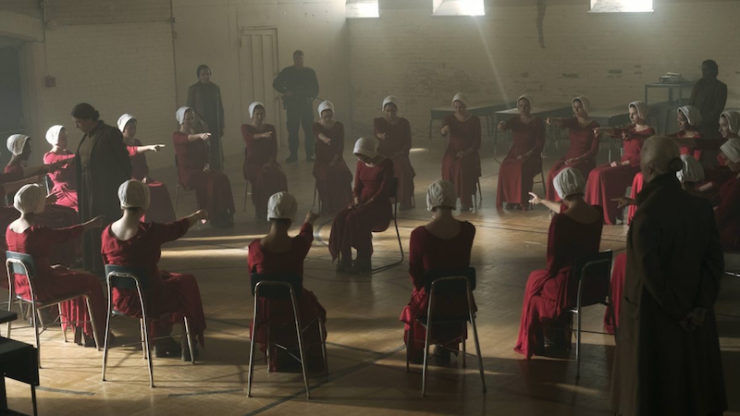Margaret Atwood’s novel The Handmaid’s Tale is such an intimate first-person account that, while it depicts a dystopian world in horrifying detail, we sometimes forget that it is the experience of just one Handmaid in the Republic of Gilead. The 1990 film adaptation did away with Offred’s interiority and supplanted that with a few scenes that Offred is not privy to, a combination that rendered the final product mostly unrelatable. Hulu’s television adaptation, however, walks a fine line between both storytelling strategies: It resurrects Offred’s narration while also expanding every aspect of the world—the private traumas and tribulations of other Handmaids and Wives, and Gilead’s deadly consequences for crimes that (for now, at least) exist outside Offred’s frame of reference.
But what a frame it is. From the first lines, you know that screenwriter Bruce Miller (The 100) and the rest of the production team took the source material as seriously as Scripture: Offred’s narration, describing the constraints of both her room and her life as a Handmaid, is lifted almost verbatim from Atwood’s text, so that the rich language describing the most harrowing horrors quickly establishes the world. But then the writers do an incredible thing: They build on Offred’s monologue, supplementing the formal language of her mantras—My name is Offred, and I intend to survive—with a running commentary that’s so acerbic, so shockingly vulgar and wonderfully snarky in this repressed society, that it makes you laugh out loud in disbelief.
This approach could also describe the adaptation as a whole: The writers, directors, and producers took the novel’s foundation and built on it, enhancing Atwood’s original ideas with subtext that feels so painfully acute that you would be forgiven for thinking that this was written in only the last five months. Because the women depicted in this series—independent, outspoken, queer, sexually autonomous women of color and white women—could have been raising their voices and signs in the Women’s March. But they also could have been the women who chose not to march, who voted on the opposing side to these women in the election. The smartest thing that the showrunners did, in adapting this story to television, was to give every single one of these women a voice.
Spoilers for the first three episodes of The Handmaid’s Tale. Any book spoilers will be whited out.
In the first three episodes, women are brainwashed through the mantra of It was her fault, and we witness at least two scenes of institutionalized rape; a deluded woman steals a baby while a more sympathetic woman contemplates the same; one Handmaid is made a literal example of the Scripture verse If thine eye offend thee, pluck it out, while another suffers the same treatment to a very different part of her body. It’s like nothing I’ve ever seen before.
The dystopian trappings are both foreign and familiar. If you’re new to the story, you’ll recognize that this is the progenitor to Divergent’s faction system built on color and values, or The Hunger Games’ rebellion against the Capitol. It is a consistently amazing fact that Margaret Atwood dreamed up this dystopia over thirty years ago, and its relevance has grown rather than diminished. Yes, the women are dressed in hyper-stylized, color-coordinated outfits that more bring to mind medieval handmaids than anything from the near-future. But these contrasts—red Handmaids, teal Wives, hospital-green Marthas—are a striking demonstration both of how these women are segregated by the system and how they choose to set themselves apart from one another. The outlandish strictures enacted by Gilead upon its inhabitants are really just trumped-up ways of representing universal, timeless women’s struggles: judgment or punishment for any sort of sexual autonomy; men feeling that they are owed women; politicians and leaders intruding upon what women do with their bodies, just because they’re capable of conceiving and giving birth—intrusions that prioritize the well being of a hypothetical baby over that of the body that would carry it.
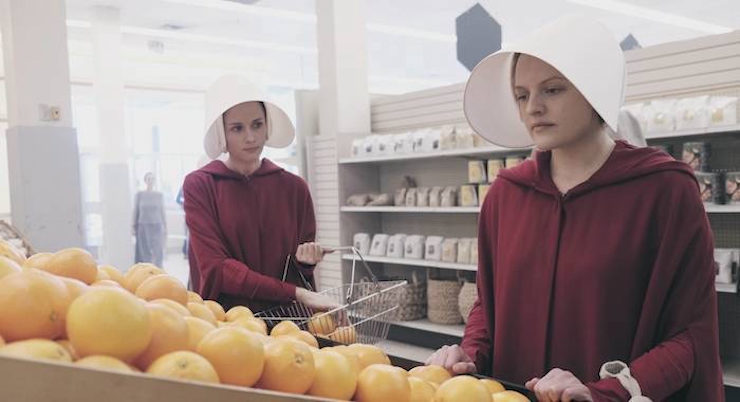
But even as these women are funneled into different classes, their identities stripped from them, they do not lose their sense of self—as demonstrated by Offred’s delightfully sharp internal monologue. While shopping with fellow Handmaids and Ofglen neutrally remarks about how Offred’s Commander likes oranges, Offred thinks, I don’t need oranges, I need to scream. I need to grab the nearest machine gun. When Nick blandly inquires as to why Offred is leaving the house, despite her comings and goings being strictly regulated for the same handful of errands, she silently snarks, No, Nick, I’m gonna knock back a few at the Oyster House bar, you wanna come along? And when she’s cornered—when Ofglen gets transferred, or the entire household believes she’s pregnant—Offred simply thinks, Fuck. It’s her true voice, the one she used in her daily life before Gilead. The one that’s forbidden now.
It could be a stretch, but I also think that the writers are incorporating the novel’s frame story. (Book spoilers, highlight to read.) Offred’s formal monologues are so different from her imagined comebacks that they almost seem to exist in a separate narrative, elevated above the day-to-day. The sound quality is also different—not quite echoing, but sounding as if it inhabits a physical space as well as a figurative one. Which is to say, please let this series end with someone finding a footlocker full of cassette tapes. (End book spoilers.)
Just as important as the aural elements are the visual ones. The interviews with costume designer Ane Crabtree (who was responsible for making Westworld look so authentic) are fascinating, from little details like sewing down the grommets of the Handmaids’ shoes so that they forget they ever had shoelaces, to the dozen different pieces that make up the Handmaids’ modest yet complicated attire. So too was the choice of a menstrual red for the gowns—really, for all of the women’s color schemes. The Marthas’ clothes are so pale as to nearly blend in with the walls of their homes. And instead of the standard blue we saw in the movie, which pits primary color shades of red and blue against one another, the Wives’ dresses are more of a teal, which clashes harshly with the red every time they share space with the Handmaids.
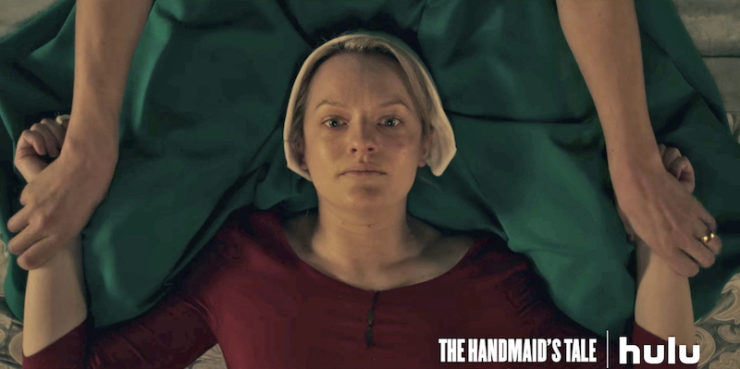
Then there’s the Ceremony. While every adaptation’s take on this institutionalized rape has not dimmed the horror of the act, the TV series has by far the best interpretation. And by “best,” I mean the most disturbing: The camera mostly lingers on Offred’s paralyzed expression and dead eyes, as she mentally disassociates from the moment even as she is being physically jerked up and down in Serena Joy’s lap, back and forth, as the Commander does his duty. Little details, like Serena Joy pulling her foot over Offred’s face to get up after it’s over, or the Commander cleaning himself before zipping up, make it all the more chilling.
For these and other scenes in the Commander’s household, it’s important that we’re in Offred’s head. But by moving from strictly first-person to a sort of omniscient third-person, the narrative both depicts Offred’s individual experiences while also transcending just her version of events.
A major criticism of the novel is the segregation of race among Gilead’s women: The Handmaids all appear to be white, with the black women sorted into the Martha class of domestic servants. While Elisabeth Moss’ Offred/June is still white, she’s in the minority among the people dearest to her: Her best friend Moira (Samira Wiley) and her husband Luke (O-T Fagbenle) are both black, and Luke and June’s daughter Hannah (Jordana Blake) is biracial. Race is not a sticking point, either, at least not in the first few episodes; I’m commenting on it more now than the series has at all so far. No longer is a straight white woman our only narrator; there are multiple points of entry for viewers.
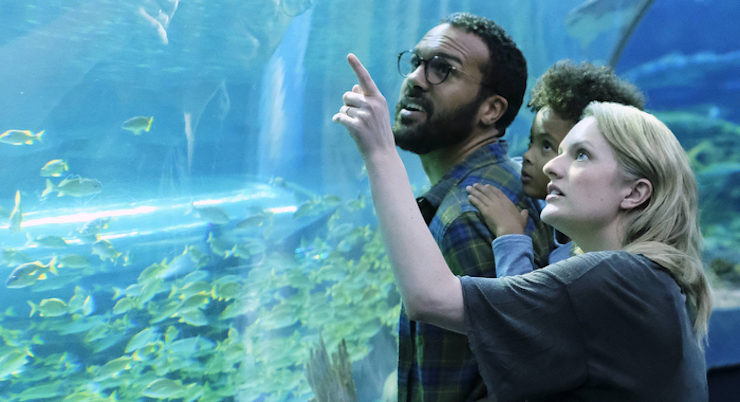
Similarly, Moira isn’t the sole queer character; Ofglen (Alexis Bledel) reveals, when talking about their lives before, that she had a wife and a son. In the book, Ofglen is something of an enigma, acting as little more than Offred’s tipoff that there is dissent swirling beneath the surface in Gilead. By giving her a family to fight for and an identity that makes her a “gender traitor” by Gilead’s standards, she becomes more than a seditious Handmaid. It’s also, I suspect, an opportunity to dramatize what could have happened to Moira, as a queer woman, had she lived out her life as a Handmaid with Offred and the others.

In addition to communicating with the shadowy resistance, Ofglen has also committed an equally grave crime: She has engaged in a relationship with a Martha. The consequences, as they unfurl in episode 3, “Late,” are gutting: she and her lover are put on trial, with muzzles strapped over their mouths so that they cannot say a word in their defense as they are declared traitors. Then “Martha 6715301” (we never find out her real name) is hanged—in an especially shocking detail, by a crane—while Ofglen is forced to watch, helpless and screeching like a wounded animal. But she isn’t granted the same fate, because not even her treason could erase the fact of her fertility. She awakens post-surgery to discover that her genitals have been mutilated—not enough to prevent her from conceiving or giving birth, but to remove any association with pleasure.
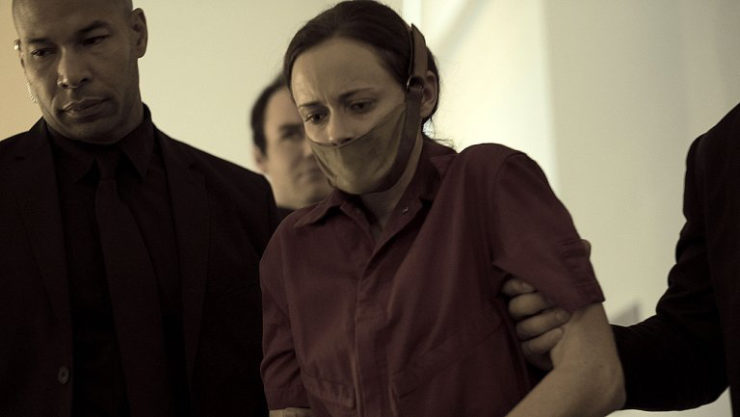
This violation of Ofglen—who at this point is finally referred to by her real name, Emily—and Janine’s plucked-out eye are both details added to the show. In the book, Aunt Lydia reminds her charges that she can mutilate their hands and feet because those do not matter for their purposes. The showrunners simply took that viewpoint to a more shocking and devastating end—because as far as the Aunts are concerned, a Handmaid does not need to look appealing to be part of the Ceremony, or experience an orgasm during it. They are simply, as Offred puts it, two-legged wombs.
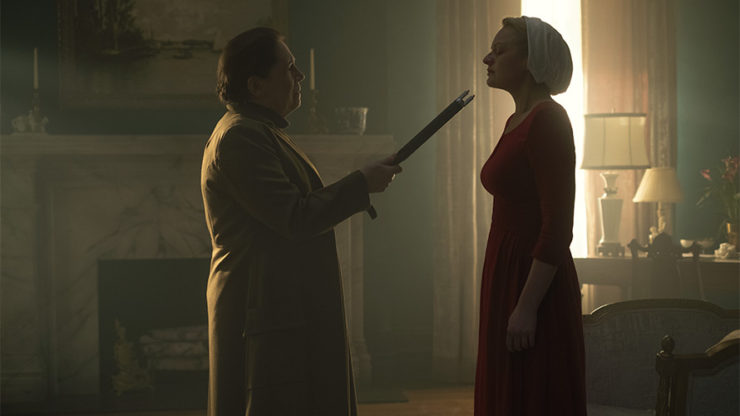
Even Janine/Ofwarren, the Handmaid who swings wildly between smarmy complacence and unhinged grief, is an object of sympathy. She may parade her pregnancy through town, but it’s a communal joy for every Handmaid: One of their ranks fulfilled her purpose and reinforced how relevant they are to the new world order. She has also created a new life, which despite its violent conception, is still precious. But whereas the birth was the peak of Janine’s story in the book, viewers stick with her through her postpartum struggle. Her daughter Angela was handed directly to the Wife after birth; Janine gets to hold her only when the baby needs to nurse. While Janine believes that she is essential to the household, what she has failed to grasp is that as soon as the baby has stopped nursing, she’ll be shuttled off to another household to do this all over again. But right now, she has tricked herself into believing that “Charlotte” (“her real name”) is hers and that the Commander loves her and their child, and is planning an escape for the three of them, this odd family linked only by blood.
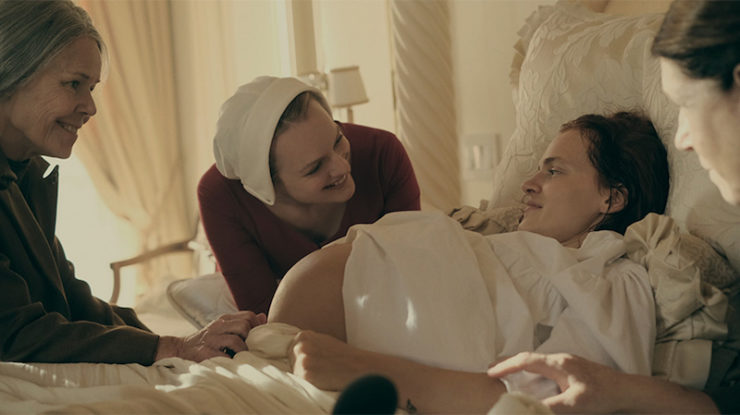
When contemplating Luke’s fate in the novel, Offred dreams up at least three different scenarios, struggling to reconcile alternate and contradictory versions of Luke in her mind. The show’s decision to follow different Handmaids through key events is much the same, a way of playing out different potential paths for Offred. “I’m not that kind of person,” she demurs to Ofglen when the latter first mentions the resistance—but what if she finally gave voice to her inner monologue? Offred’s supposedly missed period immediately elevates her to a place of privilege within the Commander’s household, with Serena Joy catering to her every need and actually thanking her for answering their prayers. Though Offred must break the news that she’s not pregnant—in a scene that made me ache for Serena Joy but also squirm away from the Wife’s cold fury—in Janine she sees the bittersweet position she could inhabit if she could only conceive. And, of course, she witnesses how dangerous it is to believe that your Commander could actually care for you simply because he fucks you and you happen to get pregnant. While Offred has not achieved the latter, her secret Scrabble game with Commander Waterford (Joseph Fiennes) is a much more dangerous form of intimacy.
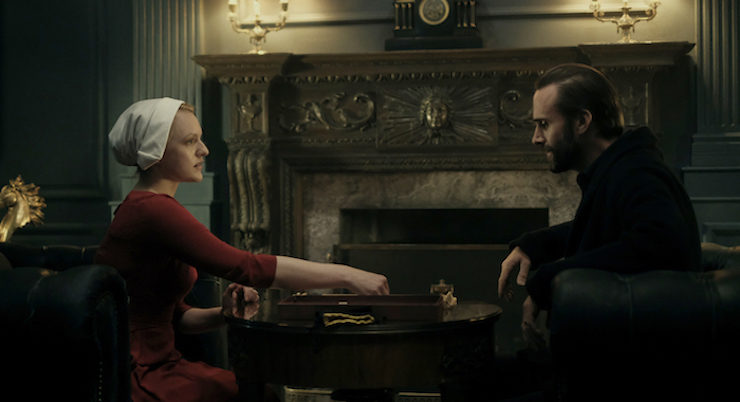
Despite the specific details of her account, book Offred is still an Everywoman, a vessel into which readers can project themselves to imagine what if this happened to me? Perhaps this is why Atwood never explicitly named her, to emphasize that anyone could become Offred if she were cycled out of the Commander’s household and someone new were brought in. Instead, the TV series has Offred name herself at the end of the pilot, conjuring up the name that used to define her—June, a nod to the long-held reader theory—and then does the same for the other Handmaids. Offred is no longer the Everywoman, but any woman.
Why should you watch this show? Because it’s already surprised me, someone who knows the story inside and out.
Natalie Zutter cannot believe she has to wait a week for the next episode. Find her on Twitter and Tumblr.










